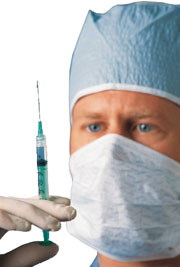- What is generalised hyperhidrosis?
- Statistics on generalised hyperhidrosis
- Risk factors for generalised hyperhidrosis
- Progression of generalised hyperhidrosis
- Symptoms of generalised hyperhidrosis
- Clinical examination of generalised hyperhidrosis
- How is generalised hyperhidrosis diagnosed?
- Prognosis of generalised hyperhidrosis
- Treatment of generalised hyperhidrosis
- References
What is generalised hyperhidrosis?
Hyperhidrosis is a condition characterised by excessive sweating; that is, the production of more sweat than is required to regulate body temperature. It is caused by non-thermoregulatory stimuli, meaning stimuli other than heat. Normally the body only sweats when it becomes hot.
Generalised hyperhidrosis refers to hyperhidrosis affecting the entire body. It is also known as secondary hyperhidrosis as it typically arises secondary to other medical conditions, predominately endocrinological (hormone-related) and infectious disorders. Generalised hyperhidrosis may also occur due to dysregulation of the autonomic nervous system, or neurological disorders such as Parkinson’s disease or spinal cord injury.
While hyperhidrosis which manifests secondary to (as a result of) another medical disorder typically affects the entire body, it may also occur at distinct anatomical sites. Generalised hyperhidrosis affecting distinct sites rarely arises secondary to a disease and is usually a result of:
- Abnormal regeneration of nerves following injury;
- Abnormalities in the number or distribution of sweat glands; or
- A defect in the blood vessels.
 |
For more information on the anatomy and physiology of sweating, see Sweating (Perspiration). |
Statistics on generalised hyperhidrosis

Amongst menopausal women, 79% in the peri-menopause (the period of time leading up to the final menstrual period) and 65% in the post-menopause (after the final menstrual period) experience vasomotor symptoms of menopause which cause excessive sweating, frequently night sweats.
Risk factors for generalised hyperhidrosis
An underlying medical condition is the key factor that predisposes an individual to generalised hyperhidrosis.
Progression of generalised hyperhidrosis
Generalised hyperhidrosis usually begins in adulthood due to medical comorbidity; that is, a disease which causes the excessive sweating (e.g. infection). It typically resolves following treatment of the comorbid condition.
Symptoms of generalised hyperhidrosis
When diagnosing generalised hyperhidrosis, the doctor will ask questions about sweating, for example how often it occurs and when it began, to determine whether or not the sweating is excessive, and to differentiate between focal and generalised hyperhidrosis. The doctor may ask about
The duration since onset of excessive sweating;
- Age at onset, with childhood or adolescent onset suggesting focal hyperhidrosis;
- Family history of the condition, with a positive family history indicating focal hyperhidrosis;
- The site of excessive sweating, with hyperhidrosis at distinct anatomical sites (commonly the arms, feet, armpits and face) indicating focal hyperhidrosis and hyperhidrosis affecting the entire body indicative of generalised hyperhidrosis;
- Experience of nocturnal (night time) sweating, with history of nocturnal sweating indicating generalised and its absence strongly suggesting focal hyperhidrosis;
- Medical comorbidities, with comorbid endocrinological, neurological, infectious and other conditions (see below) indicative of generalised hyperhidrosis;
- Frequency of sweating;
- Extent of excessive sweating, with any degree of sweating that interferes with daily activities indicating hyperhidrosis;
- Other symptoms;
- Triggers of hyperhidrosis, for example food or anxiety.
A simple scale such as the hyperhidrosis severity scale, which asks individuals to rate the severity of their symptoms on a four-point scale, may be useful. Select the response which best describes your sweating: If you are using the tool to monitor the effect of treatment, validation studies of this severity scale show that a one-point reduction in severity is associated with a 50% reduction in sweating. A two-point reduction is associated with an 80% reduction in sweating. References
How would you rate the severity of your excessive sweating?
1. Eisenach JH, Atkinson JLD, Fealey RD. Hyperhidrosis: Evolving Therapies for a Well-Established Phenomenon. Mayo Clinical Proc. 2005; 80(5):657-66. [Abstract | Full Text]
2. International Hyperhydrosis Society. Hyperhidrosis disease severity scale. 2007. [cited 1 February 2012]. Available from: [URL Link]
Generalised hyperhidrosis affects the entire body and typically occurs diurnally (in the day) and nocturnally. Following a diagnosis of generalised or secondary hyperhidrosis, further tests are used to diagnose the underlying medical condition/s, as treating these conditions is the only way to reduce the excessive sweating. The doctor will consider a range of possible conditions which are commonly associated with generalised hyperhidrosis, including:
- Endocrine conditions: including hyperthyroidism (overactive thyroid gland), hyperpituitarism (overactive pituitary gland), diabetes mellitus, menopause, and pregnancy;
- Neurological conditions: including Parkinson’s disease, spinal cord injury and stroke [link to med dict];
- Malignant disease: including lymphoma (cancer of the lymphatic system) and myeloproliferative disorders (blood cancers);
- Infections disease: including tuberculosis, human immunodeficiency virus and endocarditis (inflammation of the membranes lining the heart);
- Cardiovascular shock or failure;
- Respiratory failure.
Toxicity from alcohol or other substances may also cause hyperhidrosis, as may withdrawal from alcohol or other substances in dependent individuals. Some medications are also implicated in generalised hyperhidrosis, including:
Antidepressant medications, particularly selective serotonin reuptake inhibitors (SSRIs);
- Hormonal agents, including tamoxifen (used in breast cancer treatment) and gonadotrophin releasing hormone agonists (used in the treatment of endometriosis); and
- Antipyretics, (medicines which reduce body temperature) including aspirin and non-steroidal anti-inflammatory drugs.
In order to identify conditions which might underlie generalised hyperhidrosis and propose appropriate tests to conduct, the doctor is also likely to ask questions about your general health and other symptoms. Symptoms which may indicate a particular diagnosis include:
- Irregular or light menstrual bleeding suggests hyperthyroidism;
- Episodes of flushing are characteristic of phaeochromocytoma or carcinoid syndrome;
- Sustained or paroxysmal (episodic) hypertension in a person with generalised hyperhidrosis suggests the need for further investigations to confirm or exclude paragangliomas (usually benign tumour of the neurological tissue) and phaeochromocytomas (paragangliomas which grow in the adrenal gland).
Hyperhidrosis has similar symptoms to menopausal hot flushes. Menopausal women should not, however, assume there excessive sweating symptoms are underpinned by menopause. It is important for these women to visit a doctor and ensure other conditions are not causing the sweating.
Clinical examination of generalised hyperhidrosis
The doctor may also conduct a physical examination for signs of hyperhidrosis such as visibly damp clothing, and complications arising from constant dampness including maceration (softening of the skin) and fungal infection.
How is generalised hyperhidrosis diagnosed?
The doctor may also wish to conduct tests to ensure the underlying condition is correctly diagnosed. The choice of tests depends on the condition suspected to be causing excessive sweating.
Blood tests

- Menopause: In women of menopausal age, hormone levels in blood may be measured to confirm menopausal status. In women who are approaching but have not yet experienced their final menstrual period, a series of blood tests may be conducted;
- Hyperthyroidism: If hyperthyroidism is suspected, blood tests to measure thyroid hormones may be performed;
- Blood disorders: Blood tests can be used to assist in the diagnosis of lymphoma and myeloproliferative disorders;
- Infection.
Transthoracic echocardiogram
If endocarditis is suspected, an echocardiogram (ultrasound of the heart) may be conducted.
Chest radiograph
A chest radiograph may be performed in cases of suspected malignancy or tuberculosis.
Endocrinological investigations
If common endocrinological causes such as menopause and hyperthyroidism are excluded but an endocrinological cause is suspected, the individual may be referred for specialist assessment by an endocrinologist.
Prognosis of generalised hyperhidrosis
Generalised hyperhidrosis typically resolves when the underlying condition is treated.
Treatment of generalised hyperhidrosis

If treatment and medication adjustments do not resolve generalised hyperhidrosis, the doctor may prescribe a medicine which interferes with the sweating process.
In patients who do not respond to systemic treatments, treatments targeting the anatomical sites which are most prone to excessive sweating should be considered. Treatments indicated in focal hyperhidrosis such as surgery and botulinum toxin A injection (e.g. Botox and Dysport) may be instituted.
Article kindly reviewed by:
Associate Professor Karl Ng MB BS (Hons I) FRCP FRACP PhD CCT Clinical Neurophysiology (UK) Consultant Neurologist – Sydney North Neurology and Neurophysiology (download referral form and map); Conjoint Associate Professor – Sydney Medical School, University of Sydney; and Editorial Advisory Board Member of the Virtual Neuro Centre.
References
- Kreyden OP, Scheidegger EP. Anatomy of the sweat glands, pharmacology of botulinum toxin, and distinctive syndromes associated with hyperhidrosis. Clin Dermatol. 2004; 22(1): 40-4. [Abstract]
- Eisenach JH, Atkinson JLD, Fealey RD. Hyperhidrosis: Evolving Therapies for a Well-Established Phenomenon. Mayo Clinical Proc. 2005; 80(5): 657-66. [Abstract | Full Text]
- Haider A, Solish N, Focal hyperhidrosis- diagnosis and management. Canadian Medical Association Journal. 2005; 172(1): 69-75. [Full Text]
- Mahendiran S, Burkhart CN, Burlhart CG, Hyperhidrosis: A review of a medical condition. Open Dermatol J. 2009; 3: 195-7. [Full Text]
- Paisley AN, Buckler HM. Investigating secondary hyperhidrosis. BMJ. 2010; 341: c4475 [Abstract]
- Kim WO, Kil HK, Yoon KB, Yoo JH. Treatment of Generalized Hyperhidrosis with Oxybutynin in Post-menopausal Patients. Acta Dermato-Venereologica. 2010; 90(3): 291-293. [Abstract | Full Text]
- Moore A. Clinical vignette: hyperhidrosis. University of California- Los Angeles. Available from: [URL Link]
- Wang R, Solish N, Murray CA. Primary focal hyperhidrosis: diagnosis and management. Deramtol Nurs. 2008; 20(6): 467-70. [Abstract]
- International hyperhidrosis Society. Generalised hyperhidrosis- Clinical Guideline. [cited September 13 2011] Available from: [URL Link]
- Chelimsky TC, Autonomic dysfunction. Chapter 11 in Parkinson’s disease: diagnosis and management. Eds. Factor SA, Wiener WJ. 2008; p116. [Book]
All content and media on the HealthEngine Blog is created and published online for informational purposes only. It is not intended to be a substitute for professional medical advice and should not be relied on as health or personal advice. Always seek the guidance of your doctor or other qualified health professional with any questions you may have regarding your health or a medical condition. Never disregard the advice of a medical professional, or delay in seeking it because of something you have read on this Website. If you think you may have a medical emergency, call your doctor, go to the nearest hospital emergency department, or call the emergency services immediately.

 The duration since onset of excessive sweating;
The duration since onset of excessive sweating;







